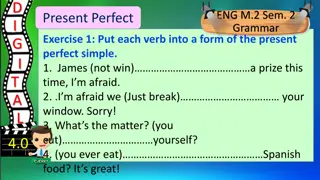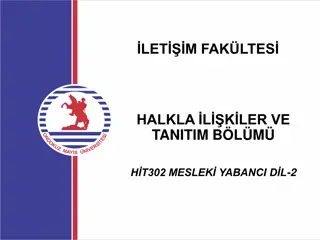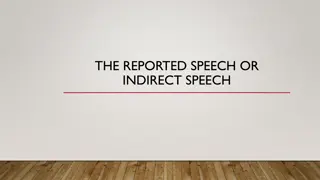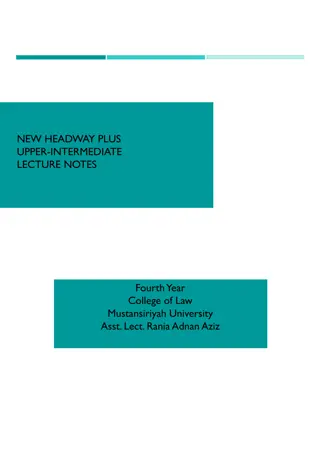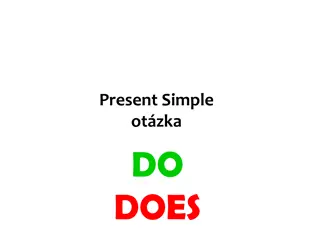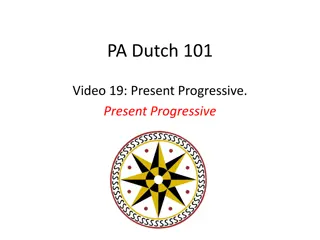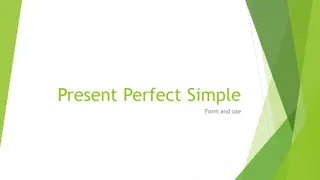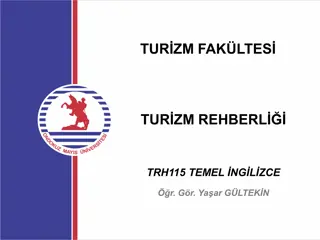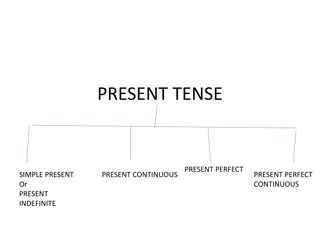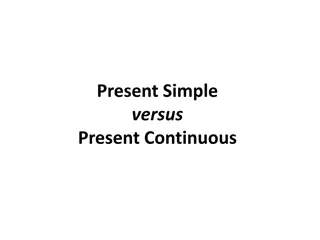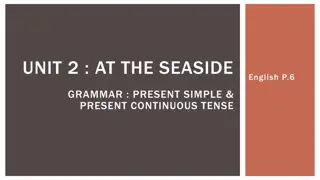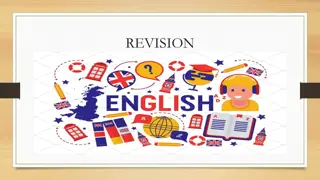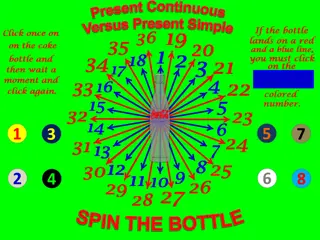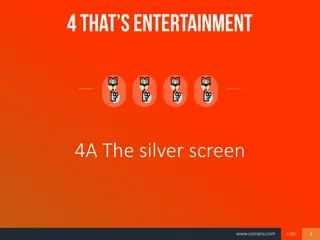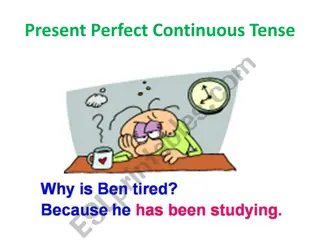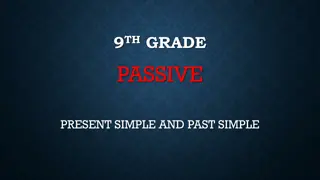
Using Present Simple Tense in English for Describing Truths and Habits
Learn how to use the Present Simple tense in English for describing present truths and habitual actions. Understand when to use this tense for expressing certainty, repeated actions, unchanging situations, and future events. Improve your English grammar with examples and explanations.
Download Presentation

Please find below an Image/Link to download the presentation.
The content on the website is provided AS IS for your information and personal use only. It may not be sold, licensed, or shared on other websites without obtaining consent from the author. If you encounter any issues during the download, it is possible that the publisher has removed the file from their server.
You are allowed to download the files provided on this website for personal or commercial use, subject to the condition that they are used lawfully. All files are the property of their respective owners.
The content on the website is provided AS IS for your information and personal use only. It may not be sold, licensed, or shared on other websites without obtaining consent from the author.
E N D
Presentation Transcript
Vocabulary verbs Volar Llorar - - - - - - - - - - Fly Cry Live Drive Have Learn Know Take Do Drink Vivir Conducir I have four cars / He has five bikes Tener Aprender Saber Tomar Hacer Beber I do exercise every morning / She does exercise every morning
Lets remember Simple present tense is used for habits, unchanging situations, general truths and future events: - The earth goes around the sun General truth (verdades generales) - We study math every Monday Habit (h bito) - I have brown hair unchanging situation (Situaciones que no cambian) - The show start in 10 minutes future events (eventos futuros) In simple present tense we use auxiliary verbs do and does - Do I - You - We - They - Does She - He - It
How and when to use the Present Simple Tense in English To describe present truths The present simple is used to describe something which is currently true (something that is true at the present time). The present simple is used with almost 100% certainty in virtually any conversation where one is describing another person, place or thing. This becomes especially evident when one is describing a friend to another person who has not met them. Or, for example, in describing a country someone is about to visit. Someone describing (Ireland to a friend who has never been there would most definitely employ the present simple Ireland is a beautiful country, The fields are incredibly green, The Irish play lots of music, etc.). Examples I study physics at the University of Kentucky. My sister works in Edinburgh. My friend is a teacher. Anthony plays football for a club. Of course, one must be careful to use the correct verb conjugations. We will touch more on this when we discuss the present simple s structure and formation. 2 Repeated actions and habits The present simple is also used to describe actions which occur with a regular frequency in a general way. Using the present simple in this case implies that the action is habitual; therefore, these types of verbal phrases involving the present simple are often accompanied by the phrase every + (week, day, month, hour, Thursday, etc.). This is not to say that such a phrase is always necessary. Examples Mike eats Mexican food every Thursday. I drive to work every day. We harvest pumpkins every autumn. Julie drinks coffee in the afternoon. As stated above, the every phrase is not always necessary. Some phrases which denote a certain moment or span of time do not require a marker such as every. In Example 4, it is stated that Julie drinks coffee in the afternoon. In this sentence the every is implied, as drinking coffee is typically a habitual action (given the nature of the substance). Depending on the situation, though it is less common, the every can be implied. Nevertheless, it is acceptable to use directly in most cases. 3 Something that is always true When something is indisputably, always true, one may use the present simple to describe its occurrence. In this case, the present simple is a way to simply state a reality that never changes and is total in nature. Examples Guitars require regular tuning. Grizzly bears are extremely dangerous. Exercise is tiresome. Traveling to Europe is expensive. In this type of grammatical situation, the verb to be is commonly used, since it implies an essential nature, an essential way of being, that never changes. Other verbs that are often used, such as require, imply a constancy of action through necessity. Guitars need to be tuned to function properly; therefore, they require regular tuning. 4 A fixed future event When describing a set future event, one can use the present simple to convey the certainty and rigidity with which that event is anticipated. Essentially, one must believe that that event will surely happen, and then use the present simple to describe that projected future event as a truth. Examples The movie begins at 19:00. I start work in August. We move to Sydney next year. The new album debuts this week. In short, the present simple is the easiest, fastest way to describe something that is foreseen with certainty without having to use more complicated future tenses, which we will touch on later. For the lazy or pressed for time, the present simple is the way to go!
Lets remember In simple present tense when we talk about she, he or it we add -s, -es or -ies to the end of the verbs: Run = runs She runs fast Play = plays He plays tennis - - Remember: - When the verb ends in -s, -z, -x, -sh, -ch or -o we add -es: - go = goes He goes to the cinema every weekend - When the verb ends in with consonant + y we add -ies: - study = studies She studies English on monday
Making sentences Affirmative form: Subject + verb + complement Examples: - - - We go to school every week / - I live in New york / - They fly very high / - She goes to school every week He lives in New york It flies very high
Making sentences Negative form: Subject + don t / doesn t + verb + complement Examples: - - - We don t go to school every week / - I don t live in New york / - They don t fly very high / - She doesn t go to school every week He doesn t live in New york It doesn t fly very high Remember: When there is does or doesn t in the sentence we must NOT add -s to the verb Cuando haya does o doesn t en la oraci n NO tenemos que agregar -s al verbo
Making sentences Interrogative form: Do / Does + subject + verb + complement Examples: - - - Do we go to school every week? / - Does she go to school every week? Do you live in New york / - Does he live in New york? Do they fly very high / - Does it fly very high?
Making sentences Answer: Yes / No + subject + do / does Examples: - Yes, we do - No, we don t / - Yes, she does - No, she doesn t - Yes, I do - No, I don t / - Yes, he does - No, he doesn t - Yes, they do - No, they don t / - Yes, it does - No, it doesn t
Lets practice 1.- Choose the correct verb for the sentence - She ___________ in Italy a) live b) left c) lives - I ______________ pizza on Saturdays a) eat b) eats c) swim - Amanda ________________ music in the theater a) study b) studies c) studys
Lets practice 2.- Write the correct auxiliary verb for each question Do - __________ you like cookies? Does - ___________ Marco enjoy movies? Does - ___________ she dance ballet? Do - ___________ Joe and Diana eat fish? Do - ___________ we go to the same school?
Lets practice 3.- Answer the questions Yes, I do / No, I don t Yes, he does / No, he doesn t - Do you like cookies? - Does Marco enjoy movies? Yes, she does / No, she doesn t Yes, they do / No, they don t - Does she dance ballet? - Do Joe and Diana eat fish? Yes, we do / No, we don t - Do we go to the same school?
Lets practice https://es.liveworksheets.com/worksheets/en/English_as_a_Second_Language_(ES L)/Present_Simple/Present_Simple_Tense_qe1735hg


